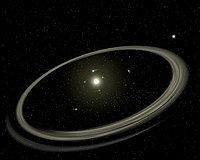
Photo from wikipedia
Revealing the mechanisms shaping the architecture of planetary systems is crucial for our understanding of their formation and evolution. In this context, it has been recently proposed that stellar clustering… Click to show full abstract
Revealing the mechanisms shaping the architecture of planetary systems is crucial for our understanding of their formation and evolution. In this context, it has been recently proposed that stellar clustering might be the key in shaping the orbital architecture of exoplanets. The main goal of this work is to explore the factors that shape the orbits of planets. We used a homogeneous sample of relatively young FGK dwarf stars with RV detected planets and tested the hypothesis that their association to phase space (position-velocity) over-densities ('cluster' stars) and under-densities ('field' stars) impacts the orbital periods of planets. When controlling for the host star properties, on a sample of 52 planets orbiting around 'cluster' stars and 15 planets orbiting around 'field' star, we found no significant difference in the period distribution of planets orbiting these two populations of stars. By considering an extended sample of 73 planets orbiting around 'cluster' stars and 25 planets orbiting 'field' stars, a significant different in the planetary period distributions emerged. However, the hosts associated to stellar under-densities appeared to be significantly older than their 'cluster' counterparts. This did not allow us to conclude whether the planetary architecture is related to age, environment, or both. We further studied a sample of planets orbiting 'cluster' stars to study the mechanism responsible for the shaping of orbits of planets in similar environments. We could not identify a parameter that can unambiguously be responsible for the orbital architecture of massive planets, perhaps, indicating the complexity of the issue. Conclusions. Increased number of planets in clusters and in over-density environments will help to build large and unbiased samples which will then allow to better understand the dominant processes shaping the orbits of planets.
Journal Title: Astronomy and Astrophysics
Year Published: 2021
Link to full text (if available)
Share on Social Media: Sign Up to like & get
recommendations!